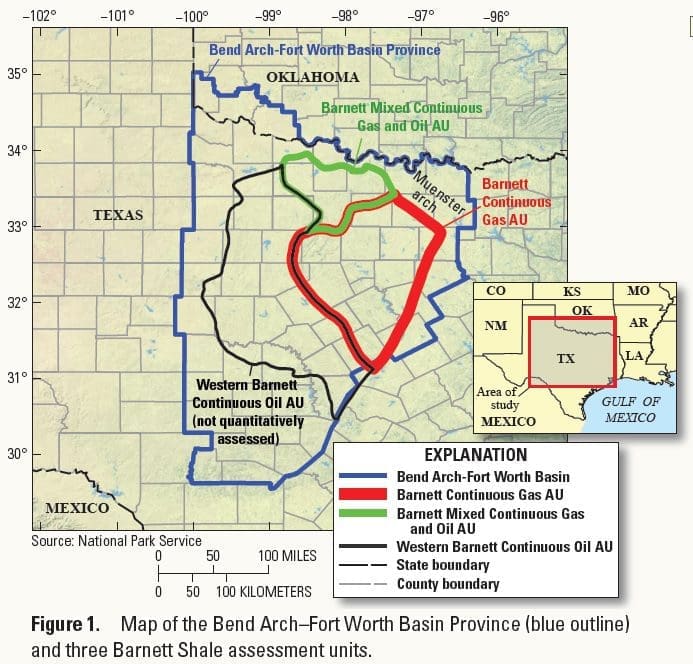The U.S. Geological Survey (USGS) recently increased its assessment of the undiscovered, technically recoverable shale gas resource in the Mississippian Barnett Shale by 26.8 trillion cubic feet.
In an update of its 2003 assessment, USGS said the Barnett Shale within the Bend Arch-Fort Worth Basin Province of north-central Texas has mean volumes of 53 trillion cubic feet of shale gas, 172 million barrels of shale oil and 176 million barrels of natural gas liquids.
“We decided to reassess the Barnett Shale following the successful introduction of horizontal drilling and hydraulic fracturing, setting the stage for the current shale gas boom,” USGS scientist Kristen Marra, who led the assessment, said in a Dec. 17 statement. “In addition, the newly revised assessment incorporates estimates for both gas and oil resources within the Barnett.”
A 2003 assessment of the Barnett Shale estimated a mean of 26.2 trillion cubic feet of undiscovered natural gas and 1 billion barrels of undiscovered natural gas liquids within the Barnett Shale. Potential oil resources were not assessed for the Barnett Shale at that time, USGS said.
Since 2003, more than 16,000 horizontal wells and 4,700 vertical wells have been drilled into the Barnett Shale, and more than 15 trillion cubic feet of gas and 59 million barrels of oil have been produced from the Barnett Shale. According to USGS, the substantial increase in potential resources is largely due to the oil and gas industry’s switch to primarily horizontal drilling within the Barnett, paired with hydraulic fracturing. The 2003 assessment relied solely on vertical drilling, USGS said.
In the last decade, the Railroad Commission of Texas (RRC) has issued about 19,500 drilling permits for the Barnett Shale. Permitting peaked in 2008 with just over 4,000 permits issued, according to RRC data. From January to November 2015, the RRC issued only 170 permits. By comparison, in the Eagle Ford Shale from January to November 2015, the RRC issued 2,170 drilling permits.
In a 2011 assessment, USGS estimated that the Eagle Ford Shale shale gas region covering Texas and Louisiana onshore lands and state waters has an undiscovered, technically recoverable resource of about 50 trillion cubic feet of natural gas, and about 2 billion barrels of natural gas liquids.
USGS updated its assessments of the Bakken Formation in North Dakota in 2013 and the Marcellus Shale along the Appalachian Basin on the U.S. East Coast in 2011. USGS estimated that the Marcellus Shale contained about 84 trillion cubic feet of undiscovered, technically recoverable natural gas. For the Bakken Formation, USGS estimated a mean oil resource of 3.65 billion barrels of undiscovered, technically recoverable oil. USGS also estimated that the Bakken Formation and the Three Forks Formation in North Dakota, South Dakota and Montana have a combined estimated 6.7 trillion cubic feet of undiscovered, technically recoverable natural gas, and 0.53 billion barrels of undiscovered, technically recoverable natural gas liquids.














